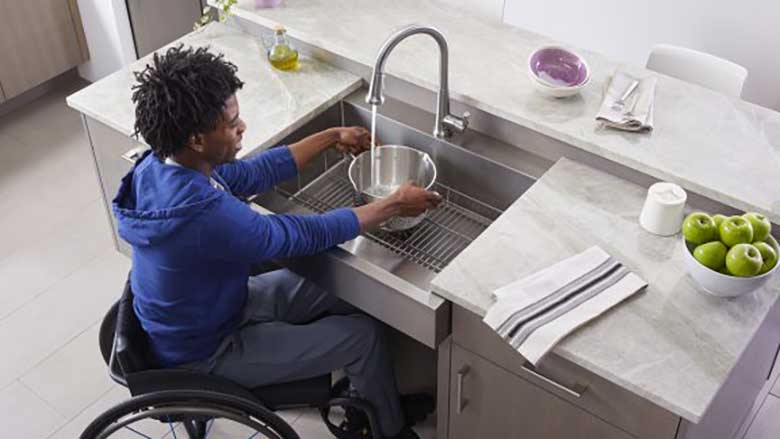In today’s world, ensuring that our homes and public spaces are accessible to everyone is more important than ever. One key aspect of accessibility is flooring. Specifically, low-pile carpeting for ADA compliance is crucial. This type of carpeting can significantly enhance the mobility and comfort of individuals with disabilities. In this article, we will explore why low-pile carpeting is essential and how it meets the American Disabilities Act (ADA) standards.

What is Low-Pile Carpeting?
Low-pile carpeting refers to a carpet that has a short and tight weave, typically less than 1/4 inch in height. This type of carpeting is known for its durability and ease of maintenance. It is often used in areas that experience high foot traffic. The low height of the pile makes it ideal for individuals who use wheelchairs or have mobility issues, as it provides a stable and smooth surface.
Why Choose Low-Pile Carpeting for ADA Compliance?
The ADA sets standards to ensure that public spaces are accessible to individuals with disabilities. One of these standards includes the type of carpeting used. Low-pile carpeting is preferred because it reduces the effort needed to move across it, making it easier for wheelchair users and those with limited mobility. Additionally, it minimizes the risk of tripping, which is crucial for maintaining a safe environment.
Benefits of Low-Pile Carpeting
There are several benefits to using low-pile carpeting, especially in spaces that need to be ADA compliant:
- Ease of Movement: The short fibers offer less resistance, allowing for smooth movement of wheelchairs, walkers, and other mobility aids.
- Safety: The risk of tripping is significantly reduced, which is essential for individuals with balance issues.
- Durability: Low-pile carpets are designed to withstand heavy use, making them ideal for high-traffic areas.
- Maintenance: Cleaning and maintaining low-pile carpeting is easier compared to high-pile options, which can trap more dirt and allergens.
How Low-Pile Carpeting Meets ADA Standards
Compliance with ADA standards is a legal requirement for public buildings and is highly recommended for private residences aiming for inclusivity. Low-pile carpeting meets these standards by providing a firm, stable, and slip-resistant surface. According to the ADA, carpets must have a pile height of 1/2 inch or less, which low-pile carpets naturally adhere to. Additionally, the edges of the carpet must be securely attached to the floor to prevent trips and falls.
Installation Considerations for Low-Pile Carpeting
When installing low-pile carpeting for ADA compliance, it is important to consider the following:
- Proper Adhesion: Ensure that the carpet is securely glued or fastened to avoid any displacement.
- Seam Placement: Minimize seams and ensure they are tightly fitted to prevent tripping hazards.
- Transition Strips: Use transition strips where the carpet meets other flooring types to provide a smooth shift and reduce the risk of trips.
Choosing the Right Low-Pile Carpet
When selecting low-pile carpeting, consider the following factors:
- Material: Choose a material that is durable and easy to clean, such as nylon or polyester.
- Color: Lighter colors can make a space feel larger and more inviting, but darker tones may hide stains better.
- Backing: Opt for a carpet with a non-slip backing to enhance safety.
Cost Implications
While low-pile carpeting may have a higher upfront cost compared to other carpeting options, its durability and ease of maintenance can result in cost savings over time. Additionally, investing in ADA-compliant features can increase property value and appeal to a broader audience.
Low-Pile Carpeting in Residential vs. Commercial Spaces
Both residential and commercial spaces can benefit from low-pile carpeting, but their needs may differ. In residential spaces, comfort and aesthetic appeal are often prioritized. In commercial settings, durability and compliance with safety standards take precedence. Regardless of the setting, low-pile carpeting offers a practical solution for enhancing accessibility.
Environmental Impact
Many manufacturers now offer environmentally friendly low-pile carpeting options made from recycled materials. These carpets not only meet ADA standards but also contribute to sustainability efforts. When selecting a carpet, look for certifications that indicate it is eco-friendly.
Maintaining Low-Pile Carpeting
To ensure the longevity of your low-pile carpet, follow these maintenance tips:
- Regular Vacuuming: Frequent vacuuming prevents the buildup of dirt and allergens.
- Professional Cleaning: Schedule periodic professional cleanings to maintain the carpet’s appearance and hygiene.
- Spot Cleaning: Address spills and stains promptly to prevent permanent damage.
Conclusion
Low-pile carpeting is an excellent choice for anyone looking to comply with ADA standards while enhancing the accessibility and safety of a space. Its benefits extend beyond compliance, offering durability, ease of maintenance, and a variety of design options. By investing in low-pile carpeting, you not only adhere to regulations but also create a welcoming environment for everyone.
For more insights on creating accessible spaces, visit Accessibility Checker. Additionally, explore our resources on home automation for accessibility and wheelchair-accessible kitchens to further enhance your home’s inclusivity.

FAQs
What is the recommended pile height for ADA compliance?
The ADA recommends a pile height of 1/2 inch or less for carpeting to ensure ease of movement and reduce tripping hazards.
Can low-pile carpeting be used in high-traffic areas?
Yes, low-pile carpeting is ideal for high-traffic areas due to its durability and resistance to wear and tear.
How often should low-pile carpeting be maintained?
Regular vacuuming and periodic professional cleaning are recommended to maintain the appearance and hygiene of low-pile carpeting.
This article contains affiliate links. We may earn a commission at no extra cost to you.

